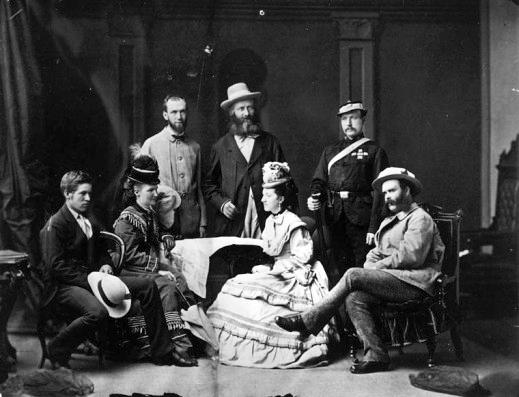A long-lasting relationship with the Royal Canadian Mounted Police
The Royal Canadian Mounted Police (RCMP) is one of the longest-standing clients and collaborators of Public Services and Procurement Canada (PSPC). Together, we’ve played a significant role in creating the Canadian identity by shaping and protecting our great nation.
Working together in the early years of Confederation
PSPC and the RCMP actively contributed to building Canada by playing a crucial role in the early construction stages of the country’s first transcontinental railway. Although their roles were very different, the Department of Public Works (one of the departments that became Public Services and Procurement Canada) and the North-West Mounted Police (Canada’s central police force that later became the RCMP) contributed to connecting Canada in a way that had never been done before.
The Department of Public Works began leading the construction of segments of the Canadian Pacific Railway in 1875. The sections of the transcontinental railway, built under the supervision of chief engineer Sir Sandford Fleming, were later transferred to the Canadian Pacific Railway Company in 1881. The railway was built to:
- unify the continent and create a unified Canadian nation
- fulfill British Columbia’s condition for joining Confederation, which consisted of creating a land transport link to the east
- access raw materials and markets in Western Canada

Members of the Sir Sandford Fleming party for the expedition through Canada in 1872. (Sitting left to right: Frank Fleming, Mrs. Fleming, Mrs. Moren, Dr. Arthur Moren.) (Standing left to right: Rev. G.M. Grant, Sir Sandford Fleming, Col. Patrick Robertson-Ross.)
Credit: Library and Archives Canada / C-002788
Before building began, a large number of surveying parties were sent across the continent to explore and assess the territory where the Canadian Pacific Railway planned on laying tracks. Sir Sandford Fleming’s party set out on an exploration trip across Canada from Montréal to the Pacific Coast to determine the most practical and economical route for a railway. Fleming began his first journey in the summer of 1871.
While Fleming was charged with making the necessary plans to carry out the work, Colonel Patrick Robertson-Ross, Adjutant-General of the Canadian Militia, was tasked with making a plan to restore peace and order in Canada’s northwest. Throughout his journey, Robertson-Ross reported fights and illegal whisky trading along the borders of the Dominion of Canada. He considered the presence of a military force in the Northwest Territories as indispensable in the interests of peace and settlement. The results of Robertson-Ross’ discoveries, which were published and presented to the House of Commons in 1872, contributed to the formation of the North-West Mounted Police in 1873. The North-West Mounted Police ensured the protection of the surveyors, contractors and railway laborers about to undertake the great work of constructing the Dominion Pacific Railway.
From the moment the police force was established, demands for its services multiplied. In 1920, the jurisdiction of the North-West Mounted Police was extended throughout the entire nation. As for the Department of Public Works, it went on to bring Canada into the modern era with its bridges, roads, airports, railways, waterways, post offices and buildings.
Today, 150 years after Confederation
As the government’s manager of real estate, PSPC cares for a variety of buildings across Canada. Today, it collaborates with the RCMP to ensure that operations are ongoing at a variety of its facilities, such as the K Division in Alberta, the J Division in New Brunswick, the E Division in British Columbia and the Depot Division in Saskatchewan.
The RCMP Academy, known as the Depot Division, in Regina, Saskatchewan, has been training members of our national police force since 1885. The Depot Division:
- includes the Police Dog Service Training Centre
- offers training to various national and international law enforcement and regulatory agencies through the National Law Enforcement Training Unit
- provides initial basic training for all RCMP cadets
Through the years, PSPC has continued to provide services to the RCMP’s Depot Division, and in 2012, it constructed the Fort Dufferin dormitory to meet the increasing needs of the cadet training program. The new facility, which is LEED (Leadership in Energy and Environmental Design) Silver certified, has 4 levels and can accommodate 224 beds. The department is also responsible for providing everything from food to training equipment to the cadets at the Depot Division.
Interesting fact
The word “Depot” is pronounced “deh-po” instead of “dee-po”.
To learn more about the story of the RCMP and its role in the development of Canada, visit the RCMP Heritage Centre in Regina, Saskatchewan.
More information
- RCMP’s page about the Depot Division
- RCMP Heritage Centre
Now that you’ve read the story, test your knowledge by taking our quiz.
- Date modified: